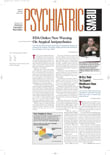It was the leading physician group advocating for publicly funded national health insurance versus the voice of organized American medicine that has for decades crusaded against “socialized medicine.”
And their divergent visions for health system reform could not be more starkly at odds: tax credits for the uninsured in a free-market, multipayer system offering a wide range of health plan options tailored to the individual, or a Canadian-style, publicly funded, and government-run single-payer system.
Those two visions clashed when psychiatrist Jeremy Lazarus, M.D., speaking for the AMA, countered Steffie Wool-handler, M.D., co-founder of Physicians for a National Health Program, in a debate sponsored by the American Medical Student Association in Washington, D.C., in March.
Physicians for a National Health Program “is a single-issue organization advocating a universal, comprehensive single-payer national health program” and has more than 10,000 members across the United States, according to its Web site.
Lazarus, a former speaker of the APA Assembly, is speaker of the AMA House of Delegates and chairs the APA Council on Advocacy and Public Policy.
The two physicians were asked to address the question, “What's it going to take to adequately address the health care crisis?”
Lazarus outlined the AMA's agenda for covering the uninsured, fixing the Medicare program, and reforming the medical liability system.
He described the AMA's vision for market and regulatory reform coupled with tax credits for the uninsured and said the plan would cover nearly all of the uninsured while preserving the greatest amount of choice for patients.
“First, [we would] establish a system of tax credits so individuals and families can buy health plans—credits that are large enough to make health plans affordable... and that individuals can get at the beginning of the year so they can pay for it up front,” he said.
“Second, let individuals and families choose their own health plan from a variety of options. We advocate incentives for insurance firms to tailor policies to meet individual needs rather than employer recipes. We encourage plans to compete on the basis of price and quality as defined by patients, not the employer or the underwriter.
“Third, we propose reform in the regulatory system to create vibrant, innovative markets for health insurance. That means replacing the regulations that now increase cost with regulations that create incentives.”
Lazarus reiterated the AMA's longstanding opposition to a government-run, single-payer system, painting a bleak picture of overregulation and long waits for care.
“In other countries what you see is rationing,” he said.“ You see patients who can't get into acute care. Patients can't see specialists. Patients are in lines. Things that people of this country would want, they are unable to get.”
Woolhandler emphasized the enormous administrative waste in America's privatized and fragmented system and pointed to Canada as a counterpoint: universal coverage with far less administrative cost.
“When you look at the total spending difference between the U.S. and Canada, nearly half of that difference is accounted for by excess bureaucracy in the U.S. system,” Woolhandler said. “By eliminating that bureaucracy, we would have $30 billion a year. That is the money we need to cover the uninsured and to improve coverage for those who have only partial coverage.”
She suggested that tax credits amounted to a 10-foot rope for a 40-foot hole. “Tax credits are too small,” she said. “To cover poor people, you have to pay the entire premium. You can't be paying $1,000 toward the premium or $3,000 toward a family premium and expecting people to pay $7,000 out of their own pocket.”
Woolhandler added that tax credits would likely discourage employers from offering health coverage. “Employers like Wal-Mart would say `Gee, tax credits are available. We don't have to offer even the paltry insurance we now offer.' So lots of people who are getting insurance through low-income jobs would find that employer-based coverage disappearing because of the tax credits. The Congressional Budget Office has done these projections and [it says] that tax credit programs would cover perhaps 2 million or perhaps 4 million Americans at a cost of $40 billion: huge cost, very few people covered.”
Lazarus agreed that tax credits would have to be large enough to provide coverage for the poor and near poor, but said that the AMA's plan would cover 95 percent of those currently uninsured.
He emphasized that there is little support among the public or among physicians for another large, government-run social insurance program, and he pointed to Medicare as an example of all that can go wrong with such a plan.
“We don't have a unified social ethic that says this is the way we want to go,” said Lazarus. “The single-payer system we have, Medicare, is really in a shambles, and you can see what happens when you have a publicly run system and what happens to it. It is not nimble. It does not change. It does not support innovation very well. Although plans are under way to perhaps make it better, it is very difficult to move the behemoth of one government system.”
He added, “Economic historians rarely agree on anything, but all of them agree price controls have never worked, anywhere at anytime. Clearly they are not working in Medicare either.”
In response to skepticism expressed by one medical student who questioned whether the AMA could claim any longer to represent most American physicians, Lazarus said that membership in the organization has stabilized and started to improve.
“The AMA represents every state medical society and every specialty in this country,” he said. “So it represents all physicians in that way. We think our priorities are clear. Our priorities are in medical liability reform, fixing Medicare, and covering the uninsured.”
A Webcast of the debate, “The AMA vs. PNHP: Showdown for a Solution,” is posted online at<www.kaisernetwork.org/health_cast/hcast_index.cfm?display=detail&hc=1382>.▪
